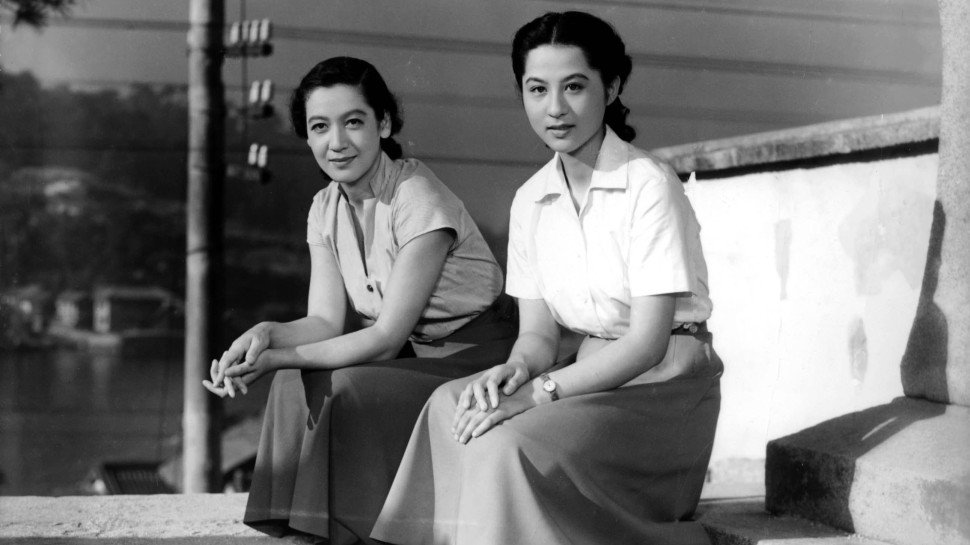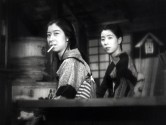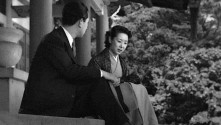



Ozu 120: The Complete Ozu Yasujiro
Presented by the Harvard Film Archive and Shochiku, in partnership with the Reischauer Institute of Japanese Studies and the Japan Foundation, this complete Ozu Yasujiro retrospective offers the rare opportunity to see all of Ozu’s extant films screened on 35mm. Five new prints were created for this occasion as the first installment of a multi-year partnership with Shochiku to create a legacy 35mm collection at the HFA, a partnership that will be celebrated with a special event in September. Seen together, Ozu's impressive oeuvre demonstrates the industrial method of a prolific artist who distilled cinema to its most essential elements over three decades of filmmaking.
Although he described himself, in a self-deprecatory manner, as a “tofu dealer,” Ozu (1903-1963) dealt in so many inconsistencies that any systemization of his oeuvre risks simplifying both the spontaneity and intent that make his films so straightforward yet slippery. Despite his influence on many who do so, Ozu did not always shoot long takes, nor did he always place his camera in a static low position. He gravitated towards the habits of everyday life, but never without the interruption of surprises, an element that Edward Yang and Kore-eda Hirokazu take to more melodramatic heights. His films are at once languid and compacted with ideas exchanged through gestures, glances, and plain assertions. Whether or not this is deliberate inactivity depends on how one measures productivity during free or dead time—a central question in the works of filmmakers like Hou Hsiao-Hsien, Claire Denis, Aki Kaurismäki, Pedro Costa and Abbas Kiarostami.
The ubiquity and far-reaching influence of Ozu owes much to the fact that he committed himself to constant self-revision, crystallizing his best inclinations as signatures and discarding weaker ones. Ozu often repurposed old material by taking apart and compositing elements of previous scripts—a process usually done with screenwriter Noda Kogo, who cowrote nearly half of his films. Fixed on perfecting his style, he meditated on his shortcomings and openly identified which of his films he thought were failures or successes. Like Abel Gance, Fritz Lang and Alfred Hitchcock, Ozu sought to update and upgrade his earlier films. But with the exception of A Story of Floating Weeds (1934), which he updated in 1959 as Floating Weeds, Ozu rarely remade entire films. Instead, he made each film a patchwork of familiar names, stories and faces. By reusing the same actors—including Saito Tatsuo, Tanaka Kinuyo, Haruko Sugimura, Ryu Chishu and Hara Setsuko—his films locate in everyday life a continual sensation of déjà vu. Consistency was the object of a steadfast pursuit for Ozu, as he gradually came to value the refinement of a mature style over a versatile experimentation with genre.
To the disappointment of his merchant parents, Ozu did not like school. He preferred watching movies, debating articles about films with his friends, and memorizing the casts of his favorites. After sending a younger male student an affectionate letter, Ozu was expelled from his school dormitory in 1920. The expulsion greatly wounded Ozu, but his alternative schooling arrangement gave him even more time to spend in the cinema. Determined to prove he could succeed without a college degree, Ozu entered Shochiku as an assistant cameraman in 1923. He quickly became a director, and in an unconventional way: by swinging at a coworker in line at the Shochiku canteen and impressing a studio executive who witnessed the incident. Scuffles had gotten Ozu into serious trouble as a schoolboy, but at Shochiku his impudence was rewarded with a promotion by studio head Kido Shiro.
Under Shochiku's rigorous schedule, Ozu completed productions within days and directed multiple films a year. Within the first decade of his career he had directed a period film (his now lost debut feature Sword of Penitence (1927)), gangster films, salaryman films, student comedies, home dramas and romantic melodramas. But it was the shoshimin eiga, or humanist films about lower-middle class life, that made Ozu one of Shochiku's preeminent filmmakers. If Ozu's films about upper-middle class life are about the acceptance of choice, then his shoshimin eiga are about the acceptance of circumstance. In the silent I Was Born, But... (1932), two boys must accept that however humiliating, their father's submission to authority as an office worker puts food on the table. The mother in The Only Son (1936), Ozu's first talkie, must accept that the sacrifices she made for her child and his material success as an adult are mutually exclusive.
From within the parameters of Shochiku-approved genres, Ozu diligently honed his craft through trial-and-error with pans and tilts, dollies and dissolves, fade-ins and fade-outs. As he gained technical proficiency, his fastidious search for beauty led him to break rules and defy conventions without hesitation. Ozu’s trademark camera setup—a low position paired with a low angle—was an unexpected discovery made during the making of the lost silent Body Beautiful (1928): to avoid tidying up the electrical cables on the floor, Ozu lowered the camera and took an immediate liking what he saw. He crossed the 180-degree line when filming characters’ conversations in close-up and arranged props differently for each camera setup, choosing composition over continuity. Though he disavowed traditional transitions and camera movements altogether by the 1950s, the variety in technique seen in Ozu’s early films show an ambitious young director willing to cut his teeth on every tool in the shed if only to renounce all but a few.
By the end of the 1930s Ozu was a regular recipient of national awards and a mainstay on best-of lists in film magazines. However, these accolades never translated to box office success, and Ozu resented the label of "critics' director" as a sign of banishment to niche tastes. Shochiku had similar concerns about Ozu's appeal to wider audiences. Before he faced any professional consequences, Ozu was drafted twice: first as a soldier in China in 1937, then as a propaganda filmmaker in Singapore in 1943. In Singapore, Ozu spent much of his time watching and rewatching prints of American films confiscated by the Japanese army, including Gone with the Wind (1939), Rebecca (1940), Fantasia (1940), How Green Was My Valley (1941) and Citizen Kane (1941)—his favorite foreign film. At the end of the war, Ozu destroyed all traces of his propaganda film, refusing to go down as a war criminal.
Ozu hardly spoke of his own wartime experiences, which concluded with a difficult period as a POW in Singapore. In his postwar films, references to the war—and Japan's role in it as a colonial power—are brief and vague in detail: mentions of forced labor, bomb shelters and battlefields; time spent in Japan-occupied territories like Singapore, Korea and Manchuria. Like the man in Tokyo Twilight (1957) who doesn't realize Japan has passed the Prostitution Prevention Law until he opens that day’s newspaper, Ozu understood that individuals experience historical change most immediately at the level of daily routine. Therefore, he preferred to depict history only insofar as it seeped into the minutiae of characters' lives: what they wear, where they eat, who they choose to marry and why. The most explicit descriptions of the war in Ozu’s films are the expressions of nostalgia and grief that punctuate get-togethers—military songs, wartime anecdotes. Cushioned by cordiality, differing opinions about the war never rise above the low stakes of a trivial disagreement about the weather.
From the 1950s and onward, Ozu shifted his focus from lower-middle class to upper-middle class families. Their basic needs for food and shelter met, Ozu's wealthier characters have enough material comfort for abstract debates to become the main struggle of their lives. But Ozu complicates the dichotomy between modern and traditional values by making a careful distinction between being modern and being young. Young people with old-fashioned beliefs appear in enough Ozu films to be considered an archetype, from the chain-smoking niece who urges her emasculated uncle to beat his wife in What Did the Lady Forget? (1937) to the modest daughter in Late Spring (1949) who finds remarriage to be a vulgar idea. But such strict adherence to ideology is not to be confused for ideological certainty; usually, the zealous characters change their minds within days and weeks. To be modern, as the youngest sister in The Munekata Sisters (1950) concludes, is to not grow old. As he advanced in years, Ozu developed a new archetype: the older person who proves to be even more modern than the youth. For instance, the irony of Ozu’s first color film, Equinox Flower (1958), is that the middle-aged father who advises each of his friends’ daughters to marry who they love has become the very corrupting force of modernization that he blames for his daughter’s decision to do the same.
Ozu held out against color for decades, until he realized that he might regret not making any color films before the end of his life. The productivity of Ozu's early career sharpened his instincts for the artistic command and sophisticated self-reflexivity he achieved with the six color films he directed from 1958 to 1962. Ozu likened his approach to selecting actors as a painter picking colors of paint, so unsurprisingly he was extremely particular about each film’s color combinations, even collecting fabric samples to determine the correct color and texture of a curtain. Each of these films is a response to what came before: the spoiled children’s scatological troubles in I Was Born, But… recall the digestive diseases that ail starving children in Passing Fancy (1933) and An Inn in Tokyo (1935), a connection through which Ozu asserts that both a healthy gut and a clean pair of pants are a luxury not to be taken for granted. Whereas Ozu’s Noriko Trilogy (Late Spring (1949), Early Summer (1951), and Tokyo Story (1953)) presents widowhood as a resignation to loneliness, Late Autumn (1960) depicts widowhood as an assertive choice to be alone and in love—a private, dignified form of happiness.
The self-contained quality of these final films led Shochiku's younger leftist filmmakers like Oshima Nagisa and Imamura Shohei (who resigned from his position as Ozu's assistant out of frustration) to decry Ozu as an insular conservative whose films deflected external influence. But Ozu proudly considered himself an individualist who followed his own path in art, no matter how out-of-fashion or late. He saw his color films as the start of a new path, but his first steps were abruptly cut short by his death to throat cancer on his sixtieth birthday. Ozu left behind fifty-six self-portraits, which like Cezanne's apples contain infinitesimal variance. But the protean patterns of his films are most pleasurable when the mind packs light enough to relish in the mystery of his intuition. One imagines the ideal viewer for Ozu’s cinema to be as relaxed and ready as the grandfather in The End of Summer (1961), who arrives at his lover's door with only the clothes on his back and a pocketful of coins. – Kelley Dong






































